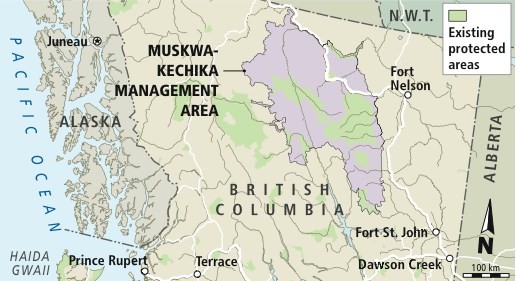We know that if we want to deal with the climate crisis, we need to act now. But climate action is not just about driving electric cars and installing solar panels. We also need to take bold steps to protect the wild places — and wildlife — we love in the face of growing climate pressures.
Fortunately, here in B.C., we have an opportunity to make a huge difference for wildlife, starting in a vast area in the north-central part of the province that is one of the most intact wild areas left on the planet. B.C.’s Muskwa-Kechika is a spectacularly wild region of rugged mountains, verdant valleys, glaciers and boreal forests. Four times the size of Vancouver Island, it is an area with few roads (98 per cent roadless) and little resource development. The result is intact forests, clean waters and healthy wildlife populations. Caribou, for example, are thriving in the Muskwa-Kechika — unlike in southern B.C., where almost every caribou population is skidding toward extinction.
As well as being ribboned by its namesake rivers (the Muskwa and the Kechika), the area contains the unprotected headwaters of the mighty Liard and Peace Rivers. But it is not just being an area with a very light human footprint that makes the Muskwa-Kechika unique. It also has a high level of habitat diversity due to its varied topography, different landforms and many lakes and wetlands — all of which provide valuable options for plants and animals looking to shift as climate heating accelerates. In particular, the Muskwa-Kechika offers wildlife important “climate ramps” — the ability to move to higher elevations along slopes leading up to the Continental Divide or along river valleys.
Recognition of the Muskwa-Kechika’s world-class features is not new. The Muskwa-Kechika Management Area was established in the late 1990s in a first effort to protect some of its most important pieces. But in the face of a hotter climate and continuing impacts on wildlife and waters from industrial development, we now understand we have to do more. With only a fraction of the area currently protected, there is still a long way to go to ensure real long-term protection for species and spaces throughout the Greater Muskwa-Kechika.
Wildlife Conservation Society Canada has mapped a larger and better-connected network of protected areas across the Greater Muskwa-Kechika. We focused on four species as our guides in this work: woodland caribou, bull trout, Stone’s sheep and moose. By analyzing the areas of most importance to these species, we were able to identify where protection of lands and waters should be prioritized. We also looked at how critical habitats for these species will shift in the face of climate warming and how we can protect those all-important climate ramps.
The result is a proposal to essentially double the existing area of protection in the Muskwa-Kechika to create a globally significant protected network in what has been called “the Serengeti of the North.” That may sound like a recipe for conflict with loggers and miners, but in reality, our proposed network has been carefully designed to avoid the few areas in the Greater Muskwa-Kechika where there is any tangible interest in resource development.
Too often in the past, governments have established protected areas only with an eye to reducing conflict with logging or mining or to protect scenic — but not necessarily highly productive — places. And too often that has left us with “postage stamp” protected areas cut off from one another and of limited value to wildlife. In the Greater Muskwa-Kechika, we can take a bolder approach that better matches the challenges of our times. Here we still have the opportunity to build something great from the ground up by using science to guide land-management decisions that will serve both people and wildlife for generations to come.
Last week, 11,000 scientists signed an open letter stating “clearly and unequivocally that planet Earth is facing a climate emergency,” adding that: “We need to quickly curtail habitat and biodiversity loss, protecting the remaining primary and intact forests.” B.C. can help a huge suite of wildlife — from bull trout to stone sheep — cope with the impacts of climate change by conserving the wild nature of the Greater Muskwa Kechika. It is the kind of farsighted climate action the world desperately needs now.
John Weaver is a carnivore conservation biologist leading field programs over the past 25 years in the western United States and Canada, focused on large landscape conservation, wildlife connectivity and adaptation to climate change.



